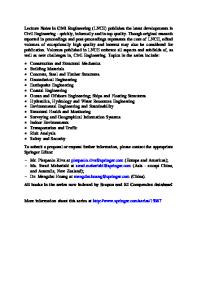Multi-Scale Analyses of Three Dimensional Woven Composite 3D Shell With a Cut Out Circle
- PDF / 3,028,724 Bytes
- 18 Pages / 439.37 x 666.142 pts Page_size
- 43 Downloads / 274 Views
Multi-Scale Analyses of Three Dimensional Woven Composite 3D Shell With a Cut Out Circle Duc Hai Nguyen 1,2 & Hu Wang 1,2
Received: 27 March 2018 / Accepted: 9 April 2018 # Springer Science+Business Media B.V., part of Springer Nature 2018
Abstract A composite material are made by combining two or more constituent materials to obtain the desired material properties of each product type. The matrix material which can be polymer and fiber is used as reinforcing material. Currently, the polymer matrix is widely used in many different fields with differently designed structures such as automotive structures and aviation, aerospace, marine, etc. because of their excellent mechanical properties; in addition, they possess the high level of hardness and durability together with a significant reduction in weight compared to traditional materials. However, during design process of structure, there will be many interruptions created for the purpose of assembling the structures together or for many other design purposes. Therefore, when this structure is subject to load-bearing, its failure occurs at these interruptions due to stress concentration. This paper proposes multi-scale modeling and optimization strategies in evaluation of the effectiveness of fiber orientation in an E-glass/Epoxy woven composite 3D shell with circular holes at the center investigated by FEA results. A multi-scale model approach was developed to predict the mechanical behavior of woven composite 3D shell with circular holes at the center with different designs of material and structural parameters. Based on the analysis result of laminae, we have found that the 3D shell with fiber direction of 450 shows the best stress and strain bearing capacity. Thus combining several layers of 450 fiber direction in a multi-layer composite 3D shell reduces the stresses concentrated on the cuts of the structures. Keywords Fibre orientation . Woven E-glass/epoxy . Multi-scale . RVE
* Hu Wang [email protected] Duc Hai Nguyen [email protected]
1
State Key Laboratory of Advanced Design and Manufacturing for Vehicle Body, Hunan University, Changsha 410082 PR, China
2
Joint Center for Intelligent New Energy Vehicle, Shanghai 201804, China
Appl Compos Mater
1 Introduction One of the numerical modeling methods currently being investigated by scientists is the multiscale modeling approach method based on finite element analysis (FEA) which has been widely used to quickly predict the mechanical properties of heterogeneous woven composite materials [1–3]. In the multi-scale modeling method, the mechanical properties of the composite structure are determined simultaneously during the analysis process based on the properties of the constituent materials forming the structure, which is very useful in the application of composite materials [4]. At the same time, the stress and strain of the structure at different loads can be obtained by FEA of each model in the multi-scale analysis separately. Fu et al. [3] proposed a multi-scale modeling approach for 3D hard joi
Data Loading...











